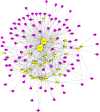Exploring induced pluripotency in human fibroblasts via construction, validation, and application of a gene regulatory network
- PMID: 31374103
- PMCID: PMC6677386
- DOI: 10.1371/journal.pone.0220742
Exploring induced pluripotency in human fibroblasts via construction, validation, and application of a gene regulatory network
Abstract
Reprogramming of somatic cells to induced pluripotent stem cells, by overexpressing certain factors referred to as the reprogramming factors, can revolutionize regenerative medicine. To provide a coherent description of induced pluripotency from the gene regulation perspective, we use 35 microarray datasets to construct a reprogramming gene regulatory network. Comprising 276 nodes and 4471 links, the resulting network is, to the best of our knowledge, the largest gene regulatory network constructed for human fibroblast reprogramming and it is the only one built using a large number of experimental datasets. To build the network, a model that relates the expression profiles of the initial (fibroblast) and final (induced pluripotent stem cell) states is proposed and the model parameters (link strengths) are fitted using the experimental data. Twenty nine additional experimental datasets are collectively used to test the model/network, and good agreement between experimental and predicted gene expression profiles is found. We show that the model in conjunction with the constructed network can make useful predictions. For example, we demonstrate that our approach can incorporate the effect of reprogramming factor stoichiometry and that its predictions are consistent with the experimentally observed trends in reprogramming efficiency when the stoichiometric ratios vary. Using our model/network, we also suggest new (not used in training of the model) candidate sets of reprogramming factors, many of which have already been experimentally verified. These results suggest our model/network can potentially be used in devising new recipes for induced pluripotency with higher efficiencies. Additionally, we classify the links of the network into three classes of different importance, prioritizing them for experimental verification. We show that many of the links in the top ranked class are experimentally known to be important in reprogramming. Finally, comparing with other methods, we show that using our model is advantageous.
Conflict of interest statement
The authors have declared that no competing interests exist.
Figures






Similar articles
-
Involvement of Polycomb Repressive Complex 2 in Maturation of Induced Pluripotent Stem Cells during Reprogramming of Mouse and Human Fibroblasts.PLoS One. 2016 Mar 3;11(3):e0150518. doi: 10.1371/journal.pone.0150518. eCollection 2016. PLoS One. 2016. PMID: 26938987 Free PMC article.
-
Stem Cell Surface Marker Expression Defines Late Stages of Reprogramming to Pluripotency in Human Fibroblasts.Stem Cells Transl Med. 2016 Jul;5(7):870-82. doi: 10.5966/sctm.2015-0250. Epub 2016 May 9. Stem Cells Transl Med. 2016. PMID: 27160704 Free PMC article.
-
Shared gene regulation during human somatic cell reprogramming.J Genet Genomics. 2012 Dec 20;39(12):613-23. doi: 10.1016/j.jgg.2012.09.002. Epub 2012 Nov 7. J Genet Genomics. 2012. PMID: 23273765
-
Concise review: the dynamics of induced pluripotency and its behavior captured in gene network motifs.Stem Cells. 2013 May;31(5):838-48. doi: 10.1002/stem.1340. Stem Cells. 2013. PMID: 23362218 Review.
-
Ground rules of the pluripotency gene regulatory network.Nat Rev Genet. 2017 Mar;18(3):180-191. doi: 10.1038/nrg.2016.156. Epub 2017 Jan 3. Nat Rev Genet. 2017. PMID: 28045100 Review.
Cited by
-
Optimal transport reveals dynamic gene regulatory networks via gene velocity estimation.PLoS Comput Biol. 2025 May 8;21(5):e1012476. doi: 10.1371/journal.pcbi.1012476. eCollection 2025 May. PLoS Comput Biol. 2025. PMID: 40341271 Free PMC article.
-
Effects of Coculture Fibroblasts and Vascular Endothelial Cells on Proliferation and Osteogenesis of Adipose Stem Cells.Comput Math Methods Med. 2022 Jan 13;2022:6288695. doi: 10.1155/2022/6288695. eCollection 2022. Comput Math Methods Med. 2022. Retraction in: Comput Math Methods Med. 2023 Jun 28;2023:9819618. doi: 10.1155/2023/9819618. PMID: 35069787 Free PMC article. Retracted.
References
Publication types
MeSH terms
Grants and funding
LinkOut - more resources
Full Text Sources

